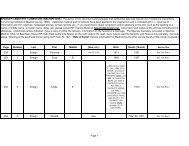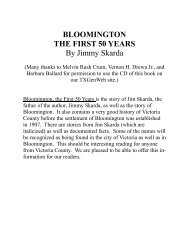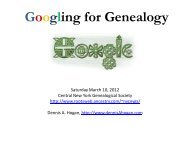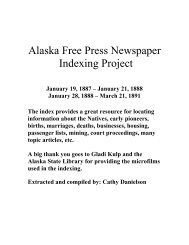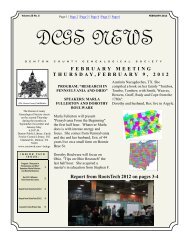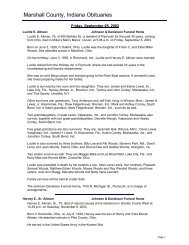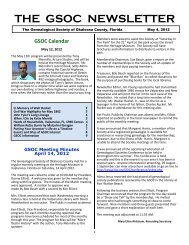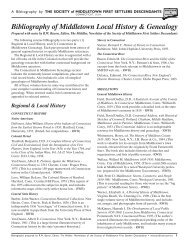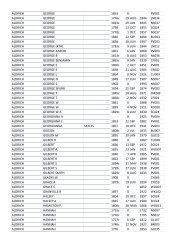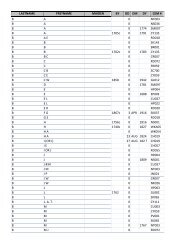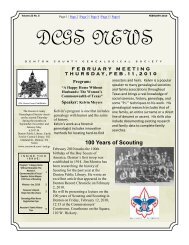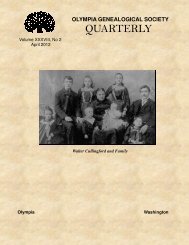Getting to the Roots of Your Family - RootsWeb - Ancestry.com
Getting to the Roots of Your Family - RootsWeb - Ancestry.com
Getting to the Roots of Your Family - RootsWeb - Ancestry.com
You also want an ePaper? Increase the reach of your titles
YUMPU automatically turns print PDFs into web optimized ePapers that Google loves.
• In 1843, <strong>the</strong> largest secession <strong>of</strong> all occurred. 451 ministers <strong>of</strong> <strong>the</strong> Established Church (over a<br />
third <strong>of</strong> <strong>the</strong> <strong>to</strong>tal) and most <strong>of</strong> <strong>the</strong>ir congregations, with o<strong>the</strong>rs, seceded and formed <strong>the</strong> Free<br />
Presbyterian Church.<br />
• In 1846, <strong>the</strong> United Secession Church and Relief Church merged <strong>to</strong> form <strong>the</strong> United Presbyterian<br />
Church.<br />
• In 1852, most Original Secession Church congregations united with <strong>the</strong> Free Church.<br />
• By 1855, nearly two-thirds <strong>of</strong> population no longer belonged <strong>to</strong> <strong>the</strong> Established Church.<br />
• In 1876, most Reformed Presbyterian Church congregations united with <strong>the</strong> Free Church.<br />
• In 1900, <strong>the</strong> UP Church and <strong>the</strong> Free Church joined <strong>to</strong> form United Free Presbyterian.<br />
• In 1929, most United Free Church congregations rejoined <strong>the</strong> Established Church.<br />
• All <strong>of</strong> <strong>the</strong>se groups are his<strong>to</strong>rically referred <strong>to</strong> as seceders.<br />
SO WHY ALL THE SECESSIONS?<br />
The major reason was <strong>the</strong> issue <strong>of</strong> patronage, which was <strong>the</strong> right <strong>of</strong> a layman <strong>to</strong> appoint a minister<br />
even against <strong>the</strong> wishes <strong>of</strong> <strong>the</strong> Kirk session or congregation. (Finally abolished for good in 1874.)<br />
OTHER NONCONFORMIST CHURCH GROUPS<br />
Several o<strong>the</strong>r nonconformist church groups have had a his<strong>to</strong>rical presence in Scotland. Being non-<br />
Presbyterian in form, <strong>the</strong>y are referred <strong>to</strong> as dissenting churches or dissenters. They include:<br />
• Independents – including Glasites, Daleites, Congregationalists and <strong>the</strong> Evangelical Union –<br />
not known for <strong>the</strong>ir record keeping.<br />
• Baptists – don’t believe in infant baptism; never large in number.<br />
• Episcopalians – strongest in Angus, Kincardine, Aberdeen, Moray, and <strong>the</strong> Western Highlands.<br />
• Roman Catholics – strongest in <strong>the</strong> Highlands and <strong>the</strong> Islands.<br />
• Wesleyan Methodists – never large in number.<br />
• Church <strong>of</strong> Jesus Christ <strong>of</strong> Latter-day Saints.<br />
• Society <strong>of</strong> Friends (Quakers).<br />
• Unitarians (illegal until 1813).<br />
• Jews.<br />
• Various o<strong>the</strong>r Protestant denominations.<br />
HOW COMMON WAS NONCONFORMITY?<br />
In 1851 <strong>the</strong>re were 1183 Established Church congregations and 2202 nonconformist congregations.<br />
CONTENT OF NONCONFORMIST RECORDS<br />
Secession and Dissenter churches may or may not have kept <strong>the</strong>ir own registers <strong>of</strong> baptisms,<br />
marriages, and burials. Records may also include minutes <strong>of</strong> meetings; lists <strong>of</strong> members; accounts<br />
<strong>of</strong> <strong>the</strong> poor; etc.



